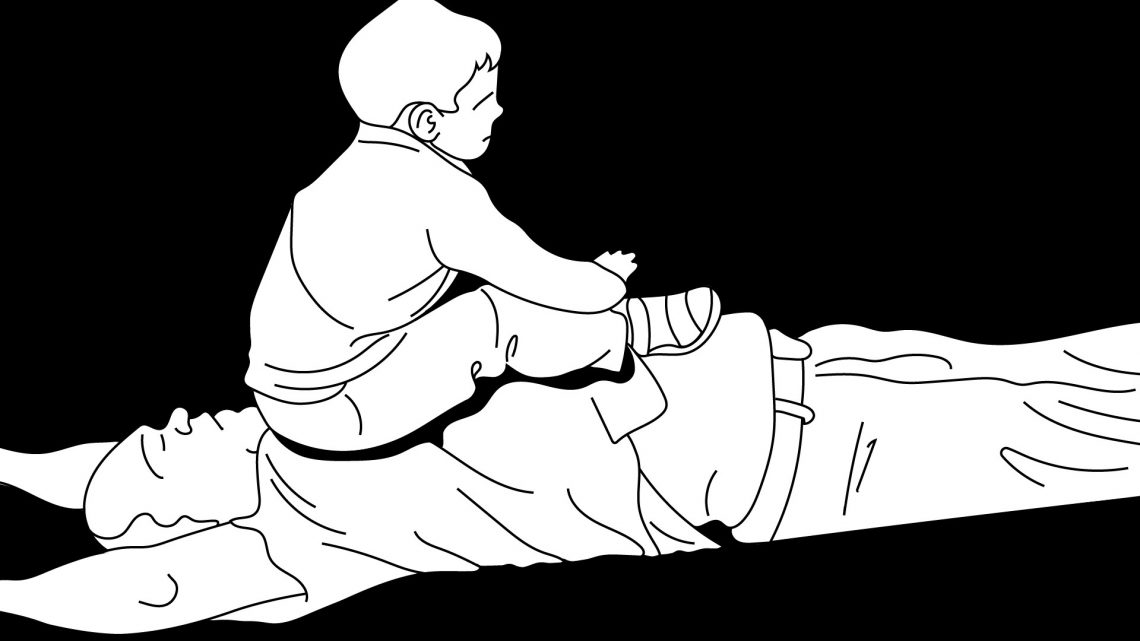
Outrage in Kashmir After Photo of 3-Year-Old Grieving His Dead Grandfather Is Allegedly Staged
July 7, 2020This article originally appeared on VICE India
Early this week, a photo of a three-year-old boy sitting atop his dead grandfather sparked a political controversy in Kashmir.
The photo emerged from the emerged from the town of Sopore in Indian-administered Kashmir, where security forces claim that 65-year-old grandfather Bashir Ahmed had been shot during a gunbattle with a Pakistani terror group known as Lashkar-e-Taiba.
The man's family, however, accused security forces of shooting Ahmed, then staging the scene “for taking pictures.” In a video statement, the family claimed that a Central Reserve Police Force (CRPF) personnel dragged Ahmed out of his car and shot him at point-blank range. Indian publication The Wire—in a widely-criticised piece—reportedly spoke to the child himself, who reiterated the accusation.
Supporting this claim is the fact that police officials from the contested Kashmiri territory later tweeted a photograph of the same boy posing with security personnel, claiming he'd been “rescued” from “getting hit by bullets during terrorist attack”.
Indian security forces denied allegations by Ahmed’s family. "I think some people have tried to give it a spin by saying that the CRPF took him (the deceased civilian) out of the vehicle and shot him. It's totally untrue," Zulfiqar Hasan, the Additional Director General of the CRPF, India’s largest paramilitary force, told local media.
Even for a region scarred by decades of violence, this incident has struck a raw nerve. “Civilian deaths are not new. What's infuriated the world in this case is how the child’s image was used by the state as a propaganda tool,” Habeel Iqbal, a human rights lawyer from south Kashmir, told VICE News. “The security forces claimed that militants killed the civilian and they saved the three-year-old. Then they put him on social media.”
The new wave of violence began in August 2019, when India unilaterally stripped Kashmir of its special status giving the region partial autonomy. Kashmir, one of the world’s most militarised zones, saw a communication blockade from India, while government officials tried to paint a picture of “normalcy” in the state. Reports of widespread protests have been periodically denied.
Iqbal said the current incident is an extension of a constructed “normal” narrative. “The state has been reduced to optics. They want to show to the world that everything is good, and the only troubles are from the ‘terrorists,’” he said.
Khurram Parvez, a human rights activist and programme coordinator of Jammu Kashmir Coalition of Civil Society (JKCCS) added that this is the first time soldiers have been used by state media to propagate its narrative. “It’s clear that the pictures and video were taken by the soldiers,” he alleged. “From now on, the soldiers will not only shoot guns, but also photographs.” No one knows who clicked the photograph.
Ahmed’s death reportedly brought hundreds of Kashmiris to stage a protest at his funeral near the main city of Srinagar. They chanted secessionist slogans, calling for “freedom” from India's rule.
Early this year, a new domicile law was introduced to award residency benefits to outsiders, whereas only Kashmiris were previously provided such benefits. The law was criticised as “illegal and unconstitutional”.
“The abrogation, domicile laws, the new media laws, etc are extremely provocative for Kashmiris,” said Parvez. “This incident has added to the anger. But we know the government will do anything to crush the anger, even if it means more arrests or killings.”
In Kashmir, mass gatherings at the funerals have always worried the state security forces. In 2016, the burial of 22-year-old militant Burhan Wani, after he was killed by the security forces, led to mass gathering and violent clashes across the Valley.
During the nationwide COVID-19 lockdown, the security forces are reportedly refusing to return bodies of dead militants to their families, allegedly to quell mass gatherings.
It’s almost a year since the abrogation of Kashmir’s special status, but protests have been sporadic. In June, the killings of at least nine militants sparked clashes between residents and the security forces.
The JKCCS put the number of extrajudicial killings of civilians by the security forces between 2008 and 2018 to be 1,081. In a review from January to June 2020, the JKCCS also recorded extrajudicial executions of at least 32 civilians in J&K, along with killings of 143 militants and 54 armed personnel.
Amnesty India has flagged the Kashmir Zone Police’s tweet with the child for violating the Juvenile Justice (Care and Protection of Children) Act, 2015.
“Kashmir is in a very uncertain and dangerous situation,” said Iqbal. “Anything can trigger anything. We may not see the protests we have seen before, but people have been registering protests in some way or the other.”
Follow Pallavi Pundir on Twitter.

